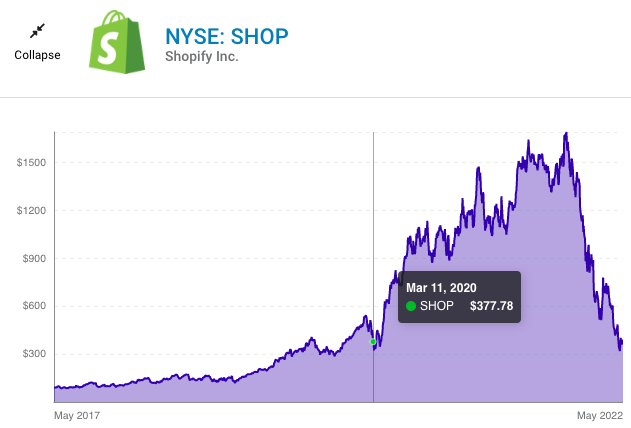Over the past six months, Shopify’s stock has dropped 80 percent from its high point. As of this writing, it’s down to its pre-pandemic value. The drop isn’t all about Shopify as a business – there are other macroeconomic factors at play too. But, for a company that was a darling of investors during the pandemic, it’s a huge negative shift, and raises questions for web developers about the future of e-commerce sites.
Despite being the clear market leader, Shopify has a lot of strong competitors – including Squarespace and Wix on the do-it-yourself side, and our beloved WooCommerce for companies that have access to dev skills. Back in February, I suggested that “Shopify will eventually suffer a similar effect to what’s happening to Netflix (that is, everyone who needs an e-commerce site already has one),” and that seems to be coming to fruition.

So, if we assume that Shopify as a company is reasonably solid (which appears to be the case) but is suffering from an industry-wide e-commerce slowdown, that means that WooCommerce developers and shop owners might experience similar challenges soon. Shopify missed its first-quarter earnings expectations by a lot this month, and CNBC explains:
“Shopify and other companies in the e-commerce sector are contending with rising concerns that they won’t be able to sustain the high-flying growth they enjoyed during the coronavirus pandemic. Shoppers flocked to online retailers during the pandemic, but e-commerce activity has cooled as the economy reopens and consumers return to stores. Amazon, Etsy and eBay have all forecast slowdowns.”
First, I think it was pretty obvious that the extreme growth during the pandemic wasn’t going to last – the entire world is working toward ending the pandemic, and thus allowing people to go back to the mall. Shopify and other work-from-home stocks, like Peloton and Zoom, were overpriced as a result of a somewhat irrational craze for tech companies that happened to be well-positioned for lockdown lifestyles. It’s always easy to say that in retrospect, of course, but clearly the combination of cheap money and an unknown post-pandemic future caused a froth in the market around these tech stocks. Now, lockdowns are mostly over, interest rates are going up, and venture capitalists are getting more cautious, which all adds up to slower growth and unsatisfying earnings reports for public tech companies.
WooCommerce is upmarket from Shopify, which is a good thing
Many companies in the WordPress ecosystem, Automattic included, are clearly seeking more lower-end, entry-level, do-it-yourself customers – and these are exactly the folks for whom Shopify is competing in the e-commerce space. This also seems to be the theory behind a greater focus on WordPress Full-Site Editing as a way to compete with Squarespace and Wix for entry-level users, although that feature set is half-baked so far.
In my view, aiming for a large number of entry-level users is an attractive business model when you are pitching VCs and want to show astonishing future growth forecasts, but it is much less valuable when you actually have to operate a company under difficult economic circumstances. Shopify is mostly suffering right now because it can’t achieve the growth rate investors want, which is all about adding new subscribers. Netflix is struggling with the same thing. If your company is built on the idea that you will achieve infinite growth over the long term, you end up unceremoniously laying people off at the first sign of a slowing trend. If I were building a Squarespace competitor, I’d be worried about this same dynamic biting me a few years down the road.
The blessing for Automattic (which owns WooCommerce) and the WordPress open-source community is that WooCommerce really has not yet evolved into something that DIY users can pick up and use to build a quick e-commerce site. It’s not even included in this 2021 pie chart of Shopify competitors, because it is almost unusable unless you have the ability to write code. Many in the WordPress industry would cringe at that idea, but now that e-commerce growth is slowing, the fact that WooCommerce is a high-code solution might make it more stable and attractive to more-advanced online sellers.
In fact, this is the progression we see with our clients: if you are selling a few products, we recommend you start with Shopify and get a basic site up for a few bucks a month. Prove your concept, then talk to us about a highly custom WooCommerce shop that does everything you’ve dreamed of – and you can make an upfront investment in a WordPress-WooCommerce site rather than paying $2,000+ a month for the premium Shopify offerings. Successful shops grow out of Shopify and choose WooCommerce for the increased flexibility that comes with a high-code, self-hosted solution.
I’ve talked in the past about how I believe that Understrap is well-positioned to serve the high-code market as most other WordPress software makes the dubious choice to address entry-level users. If I were in charge of WooCommerce, I’d probably make a similar play. Let Shopify, Squarespace and Wix duke it out for the low-end market, and do everything you can to help WooCommerce corner the market for higher-end, highly custom e-commerce solutions. WooCommerce may not be a plug-and-play solution for entry-level users, but the higher-end positioning is a good fit for its existing feature set and a way to carve out a significant piece of the e-commerce market, even when economic conditions pinch seller margins or slow down the creation of new stores.
And if you really want to address the entry-level market and compete with Shopify, Brian and I think an open-source, fully-portable, DIY WooCommerce platform would be pretty cool. 🙂


